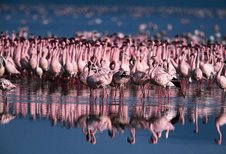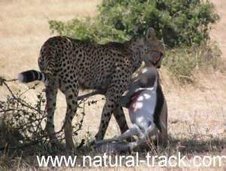Uganda may not boast of huge and well-developed national parks
like neighboring Kenya and Tanzania, but for the adventurous, Uganda is a
place to go. I have no doubt, Uganda is one of the most beautiful
countries in Africa, with fantastic natural scenery and boasting half of
the world’s remaining mountain gorilla population. It also offers
world-class white water rafting at the source of Nile and some of the
region’s most peaceful national parks. Unlike other neighboring
destinations, wildlife viewing in Uganda doesn’t involve long waits in
line behind a dozen or more vehicles.
The natural attractions are among the best in the region, and as
tourism is still being re-established, there simply aren’t the crowds
found elsewhere. After years of misrule, there is a turnaround in
numbers of animals especially elephants and antelopes, which were
butchered by undisciplined soldiers and poachers during the reign of Idi
Amin.
Currently, the Uganda Tourism is just a peaceful endeavor whose
incredible activities translate to lifetime experiences. Visitors mostly
go to Uganda to watch gorillas which are found in southwestern Uganda
in two of the only four parks in the world where these gentle giants
live. One park is Mghahinga, where chances of seeing the mountain
gorillas is a bit tricky but assured, and my favorite park in Uganda,
the Bwindi Impenetrable Forest where you will surely see a gorilla
family during its morning nap or late afternoon siesta after a good
meal.
Although gorilla watching permits are expensive with chains of
protocols and formalities to follow, it is undoubtedly a worthy cause.
In most cases, I prefer services of the local tour operators as they are
conversant with these logistics. For instance; if you want to track the
gentle giants, you have to wait in order to be put on the manifest of
those who have been permitted. This is not a guarantee thou! You could
be eliminated from the list on a slight suspicion of illness like flu
because gorillas easily catch human diseases to which they have no
immunity. That is not unfair to you buddy! Imagine how sensitive and
vulnerable these cousins are to human illnesses. Just understand!
Uganda is also one of the best places in which to watch
chimpanzees, man’s closest cousins. These primates are seen easily in
Kibale Forest National Park and in the Budongo tropical forest where the
harvesting of trees for timber is threatening their existence. There
are also chimps in Chambura River Gorge in Queen Elizabeth National
Park. Meanwhile an island sanctuary for chimpanzees has been set up in
Queen Elizabeth National Park.
Uganda has also a number of monkey families which include the
yellow baboon, which has a dog-like head, the Patas, which dwell in the
savannah, four races of the vervet monkey; the blue monkey is common in
most forests and the red-tailed monkey. There is de Brazza’s monkey,
L’Hoest monkey in Kibale Forest National park, and Wolf’s guenon, or
Hamlyn’s guenon. Grey-cheeked mangabeys are found in Kibale forest. You
will also enjoy sighting the black-and-white Colobus monkey which is
hunted by poachers for its beautiful coat which musicians use as a
waistband during the local dances.
At a glance, from the highest mountain range in Africa, the
Rwenzori Mountains; to one of the most powerful waterfalls in the world,
Murchison Falls; or perhaps the highest primate density in the world,
in kabale forest National park – Uganda has all this and more. It’s a
beautiful country with a great deal to offer, and sooner or later the
tourist hordes will ‘discover’ its delights – make sure you get there
before they do.
One of these great delights of Uganda is Bwindi – A magnificent
verdant swathe across the steep ridges of the Albertine Rift Valley,
this ancient rainforest – one of the few in Africa to have flourished
throughout the last Ice Age – is home to roughly half of the world’s
mountain gorillas.
Looking deep into the expressive brown eyes of these gentle
giants is surely the most exciting and emotional wildlife encounter that
Africa has to offer – but we should not let it distract from Bwindi’s
broader biodiversity, a result of its immense antiquity and an altitude
span from 1,160 to 2,607m.
The national park has 90 mammal species, including 11 primates,
of which the black-and-white colobus, with its lovely flowing white
tail, is prominent. The forest birding ranks with the best in Uganda,
with 23 highly localized Albertine Rift endemics present.
Bwindi can be reached from Qeen Elizabeth National Park in the
north (2-3 hours), from Kabale to the south (1-2 hours), or from Kampala
via Mbarara (6-8 hours). The roads meet at Butogota, 17km from the
Buhoma entrance gate and 4×4 drives is recommended during the rains.
Hurry and discover Uganda before the rest of the world discovers the jewel off the beaten track!
PKP- Kenia Safary desk
Subscribe to:
Post Comments (Atom)









No comments:
Post a Comment